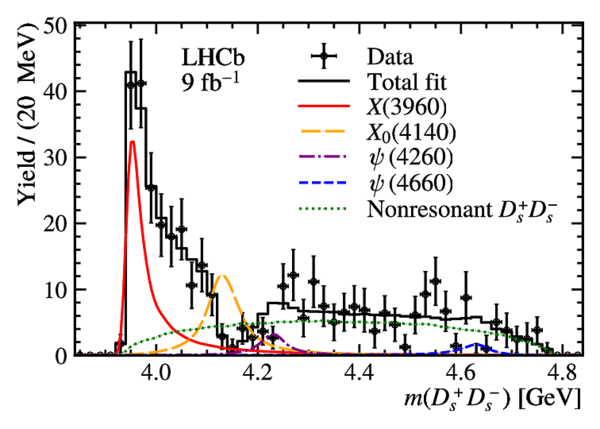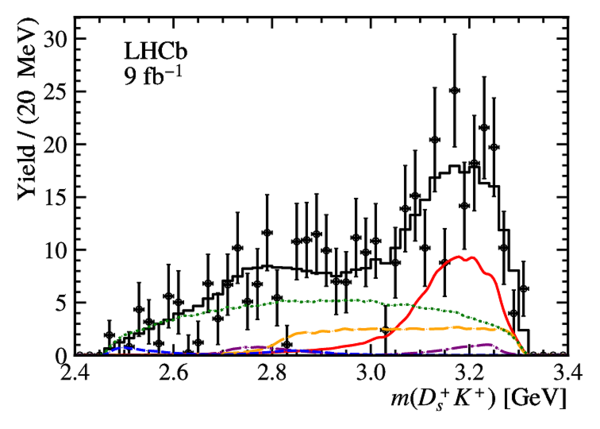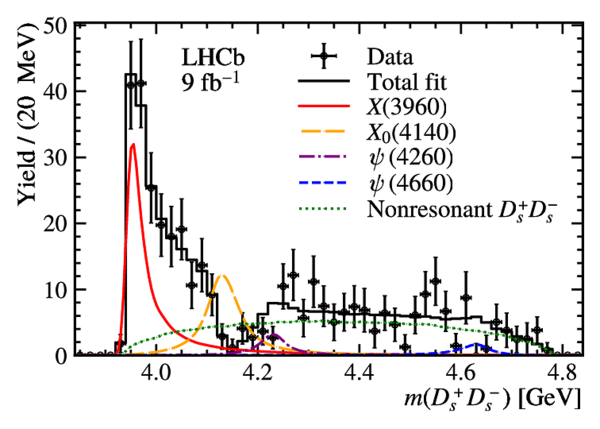Observation of a resonant structure near the $D_s^+ D_s^-$ threshold in the $B^+\to D_s^+ D_s^- K^+$ decay
[to restricted-access page]Information
LHCb-PAPER-2022-018
CERN-EP-2022-200
arXiv:2210.15153 [PDF]
(Submitted on 27 Oct 2022)
PRL 131 (2023) 071901
Inspire 2690240
Tools
Abstract
An amplitude analysis of the $B^+\to D_s^+ D_s^- K^+$ decay is carried out to study for the first time its intermediate resonant contributions, using proton-proton collision data collected with the LHCb detector at centre-of-mass energies of 7, 8 and 13 TeV. A near-threshold peaking structure, referred to as $X(3960)$, is observed in the $D_s^+ D_s^-$ invariant-mass spectrum with significance greater than 12 standard deviations. The mass, width and the quantum numbers of the structure are measured to be $3956\pm5\pm10$ MeV, $43\pm13\pm8$ MeV and $J^{PC}=0^{++}$, respectively, where the first uncertainties are statistical and the second systematic. The properties of the new structure are consistent with recent theoretical predictions for a state composed of $c\bar{c}s\bar{s}$ quarks. Evidence for an additional structure is found around 4140 MeV in the $D_s^+ D_s^-$ invariant mass, which might be caused either by a new resonance with the $0^{++}$ assignment or by a $J/\psi \phi\leftrightarrow D_s^+ D_s^-$ coupled-channel effect.
Figures and captions
|
Dalitz-plot distribution for the $ B ^+ \rightarrow D ^+_ s D ^-_ s K ^+ $ decay after background subtraction. |
Fig1.pdf [15 KiB] HiDef png [183 KiB] Thumbnail [193 KiB] *.C file |

|
|
Background-subtracted invariant-mass distributions (top left) $ m( D ^+_ s D ^-_ s )$ , (top right) $m( D ^+_ s K ^+ )$ and (bottom) $ m( D ^-_ s K ^+ )$ for the $ B ^+ \rightarrow D ^+_ s D ^-_ s K ^+ $ signal. The projections of the fit with the baseline amplitude model are also shown. |
Fig2a.pdf [36 KiB] HiDef png [284 KiB] Thumbnail [231 KiB] *.C file |

|
|
Fig2b.pdf [33 KiB] HiDef png [236 KiB] Thumbnail [185 KiB] *.C file |

|
|
|
Fig2c.pdf [33 KiB] HiDef png [238 KiB] Thumbnail [187 KiB] *.C file |

|
|
|
Background-subtracted distributions of the $ D ^+_ s D ^-_ s $ invariant mass of $ B ^+ \rightarrow D ^+_ s D ^-_ s K ^+ $ decays with fit results obtained from (left) two-channel Flatt\'{e}-like and (right) $K$-matrix parameterisations. The fit projections for the $ D ^-_ s $ $ K ^+$ and $ D ^+_ s $ $ K ^+$ invariant-mass spectra look very similar to the baseline model. |
FigS1a.pdf [36 KiB] HiDef png [283 KiB] Thumbnail [230 KiB] *.C file |

|
|
FigS1b.pdf [32 KiB] HiDef png [247 KiB] Thumbnail [197 KiB] *.C file |

|
|
|
Animated gif made out of all figures. |
PAPER-2022-018.gif Thumbnail |

|
Tables and captions
|
Summary of the main results obtained with the baseline model, where the first uncertainty is statistical and the second systematic. The last column shows the signal significance with (without) the systematic uncertainty included. |
Table_1.pdf [69 KiB] HiDef png [55 KiB] Thumbnail [26 KiB] tex code |

|
|
Summary of the systematic uncertainties on the parameters measured in the amplitude analysis. Mass ($M_0$) and width ($\Gamma_0$) are in units of MeV, while fit fraction ($\mathcal{F}$) is in %. |
Table_2.pdf [66 KiB] HiDef png [70 KiB] Thumbnail [32 KiB] tex code |

|
|
Main results found in two-channel Flatt\'{e}-like parameterisation, where the coupling strength of the $X(3960)$ state to $ D ^+_ s D ^-_ s $ ($ D ^+ D ^- $) is obtained to be $0.33\pm1.18$ ($0.15\pm0.33$) $\text{ Ge V}$ . Uncertainties are statistical only. The large uncertainty on $\Gamma_0$ for the $X(3960)$ state is due to the large uncertainty on the coupling strengths. |
Table_3.pdf [69 KiB] HiDef png [61 KiB] Thumbnail [31 KiB] tex code |

|
|
Main results found from the $K$-matrix fit. Uncertainties are statistical only. |
Table_4.pdf [70 KiB] HiDef png [48 KiB] Thumbnail [22 KiB] tex code |

|
Created on 02 May 2024.
